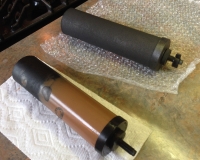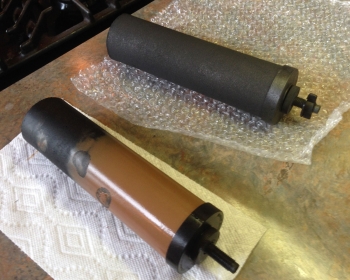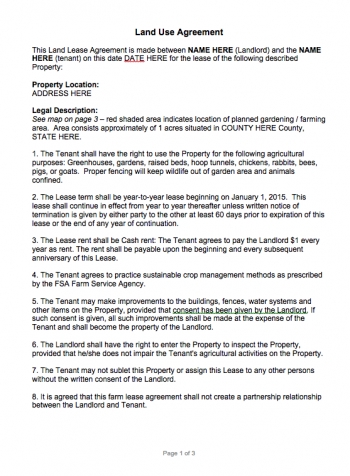 Nate Covington
Private Citizen
Nate Covington
Private Citizen
Homestead
Chickens, Greenhouses, Consulting
Homemade Greenhouse (real lumber)
Want to build a greenhouse so you can start working towards self-sufficiency, eating healthier food, etc? Here is a free greenhouse design that includes a storage shed, for storing garden tools, food for our livestock, bales of hay, and the like.
I started researching various methods of building greenhouses, ranging from inexpensive plastic hoop tunnels to the pre-built kits made from metal tubing and glass panels. I also considered storage solutions like shipping containers, pre-built sheds you can buy from major retailers, and amish-style pole barns.
Berkey Water Filter Review: 3 Years Later (Pics)
I had written a review of my berkey water filter when we first purchased it in 2014. We have been using it nonstop, putting approximately 1 gallon per day through it from our city tap water. If you refer to the photo, you can see the layer of fine sediment (dirt) coating the bottom two-thirds old filter. Note that the filter was still working fine, the water tasted great, but the upper tank of the filter wasn't draining because of the clogged filter. It was taking a full night to filter just 1 gallon of water. After replacing the (2) filters, we are now filtering a gallon in less than an hour.
Below is the letter that we sent to Berkey (and their response). Enjoy!
Demonstration: 12 Volt Off-Grid Water Pump
I've written previously about my first off-grid solar power setup. Now, I want to share the addition of a 12-volt water pump.
Product Review: SEAFLO 12V 5.5 GPM 60 PSI Water Diaphragm Pressure Pump
I purchased this water pump so that we can pump harvested rainwater out of our IBC 275 gallon totes - uphill - to our plants. I can plug the water pump directly into my battery booster, my truck, or another vehicle's battery. I've heard that this will also operate when directly connected to a solar panel (no battery required) but I haven't tested this yet.
Homemade Livestock Hauler Trailer
I recently used this trailer to bring our pigs in for processing, figured it might be helpful for others to see how it was built. The sides are built up to around 3 feet high with 2x12" rough cut material, pressure treated 4x4's, and half-inch carriage bolts. I also added hog panels to bring the overall height of the walls to over 5 feet.
One of our major objectives was to be able to restore the trailer to its original "equipment hauling" function, meaning the walls need to come off easily. (Why buy multiple trailers...?)
How our grandparents did it: farm ponds in 1950's America
Growing up, I spent a lot of time on my grandparents' 20-acre farm in Ottsville, Bucks County, PA. They purchased the raw land in the 1960's and built a house on it. The property has a pond, maybe 100 feet in diameter, and it always stays full because it is fed by an active stream. I went ice skating on it during the winters. They raised beef in the lower fields and watered the animals using the water from the stream that runs through the property. It was only a sunny, but I caught my first fish out of that pond.
My grandparents were born a few years before the Great Depression and I frequently to ask them questions about their perspective on modern society. They lived through World War 2, Vietnam, 9/11, and Barrack Obama. Recently, the conversation turned to water management and I brought up their pond. It turns out that building small ponds was a popular thing to do after World War 2. Today, who knows how many permits and inspections you need, and from which bureaucratic agency.
My first adventure into off-grid solar: a sub-$200 kit
By now everyone has heard about using solar energy to generate power. Sometimes, you heat water and circulate it using a pump. Other times, you capture electricity and store it in batteries for later, or sell it back to the grid.
My First Kit: Good for camping
Kit consists of:
Free Fix for Wet Basement: Diverting water using keylines
During a recent rainstorm, we had multiple inches come down over the course of a few hours. A rush of water coming down from the street caused our perimeter drain to start filling up with dirt, so we added a "keyline" uphill from the drain to divert water away from the problem area before it even got close.
“Dirt Rich” Community Composting Program
We are working with a handful of neighbors to get a small-scale community composting program started. The following text is copied from a Word Document that you can download below as an attachment. We encourage everyone to participate in a community program like this, at some level. Even if you're not gardening at home, you are still producing food scraps!
DIY: A Freezing Temperature Friendly Pig Watering System (how-to, with pics and video)
Tired of hauling water and stomping ice out of containers? I have the solution.
Background:
This is our first attempt at raising pigs in the back yard. We built a basic fence and pig house, got the pigs, and started feeding and watering them. We were hauling 5 gallon buckets of water for a short time before we realized a better solution was in order. We have two of these 275-gallon water totes: one under our deck that hooks up to the gutter, and another down by the pigs. We fill the one using rain water and then use a long hose to fill up the other tank down by the pigs. No more carrying water! The hardest part was figuring out how to keep the whole thing from freezing solid during the winter, as it typically hits single digits in January and February here in Northeast PA.
Caution:
Since water and electricity do not mix well, it is important that you install a ground rod next to your tank. I installed my ground rod about 3 feet away from my tank and ran a long copper wire up the side of the tank and down into it. If you are not comfortable installing a ground rod yourself, have an electrician come do it for you. This way, if something goes wrong with one of the electric heaters, it will not shock us or the pigs. Be sure to check your wires regularly (every few months, at least) and replace things before they wear out.
How to rent land from your neighbor for homesteading
We have been fortunate enough to have a neighbor that was willing to let us expand our backyard homestead operation onto their property. They were concerned about us developing the property and claiming "squatters rights" to it, so they asked that we write up a contract for everyone to sign. The purpose of sharing this document is so that other folks, who are interested in homesteading and sustainable agriculture, can work together and do the same thing while protecting themselves legally.
Note: The information contained herein is for informational purposes only as a service to the public, and is not legal advice or a substitute for legal counsel.
Product Review: PFERD Chain Sharp®
There are a lot of DC and AC-powered saw sharpeners available, and they seem nice, but I didn't want to buy one. Mainly because I can bring a chain into the local shop and they will sharpen it for about $6. And for $6, you walk out with a chain that is "like new." However, they can only sharpen a chain 5 times using their big machine before there is no more teeth remaining. I wanted a sharpening solution that would accomplish a few things:
- It must work without electricity. I don't want to bring a battery, inverter, or need to stand near my truck in order to sharpen my chain.
- It must be simple to operate. I am not a professional lumberjack and never intend to be.
Thoughts on owning free-range, egg-laying chickens
To the right, you’ll see the chicken coop that my wife and I built ourselves. We’ve been working on it over the last year or so, making adjustments and enhancements, so I want to write about what we’ve learned. We refused to spend hundreds of dollars on just their coop so we got some free pallets from down the street and scavenged for scrap wood.
-
“The refusal of King George to allow the colonies to operate an honest money system, which freed the ordinary man from clutches of the money manipulators was probably the prime cause of the revolution.”
- Benjamin Franklin






















